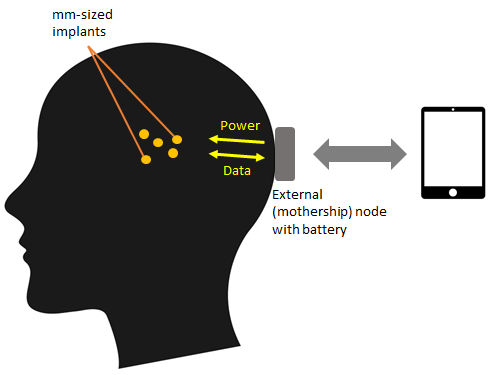MSc thesis project proposal
[2021] Network of individually addressable ultrasonically powered implants
Massive and distributed neural recording/stimulation platforms have attracted a lot of interest during the past decade. The Neuralink, Neurograin, and Neural Dust projects are just a few of many well-known examples. One of the main objectives of such platforms is unlocking the mystery of neural network functionality. Despite all the advances in neuroscience and neural technology, there is yet no clear understanding of the central nervous system (CNS), in particular the interconnectivity of the various regions of the brain. Finding and exploiting the correlations between different neural activity in different regions of the CNS is an attractive example both for neuroscience and therapeutic applications. Prosthetic applications such as cortical visual prostheses and brain-controlled robotic arms are some other motivations for such platforms. Finally, there is an increasing interest in placing neural recording and stimulation sites far from each other for closed-loop neuromodulation systems with enhanced functionality and efficacy. High-density rigid electrode arrays cause more-than-required tissue damage for all the aforementioned applications, especially when a distributed/deep-in-tissue neural interface is required. Addressing this problem, Neuralink has proposed robotically assisted insertion of thousands of flexible electrodes with micro-scale thickness and 20-mm length. However, the system is still wired, and the electrodes are limited in the depths that they can reach. An alternative solution is the use of distributed injectable wireless micro-scale devices. Even though there are some RF-powered devices for this purpose, ultrasonically powered devices are more promising because of their superior scalability and energy harvesting attributes when implanted in deep regions of the body.
One of the less-investigated requirements for massive and scattered neural interfaces networks are lightweight protocols for addressing individual implants. Thus, defining lightweight and chip-scale communication protocols and addressing strategies for a network of ultrasonically powered implants are the project's main objectives.
Assignment
1. Literature review on lightweight and IC-level network implementation for biomedical applications.
2. Proposing a lightweight network for individually-addressable ultrasonically-powered implants.
3. Make a proof-of-concept benchtop prototype in our Ultrasonic Lab.
4. Transistor-level design of the proposed idea in TSMC 40nm technology.
Requirements
The ideal candidate has the below attributes:
1. MSc student in EE Microelectronics;
2. Familiar with basics wireless network topologies and protocols;
3. Experience with IC design in the Cadence design suite;
4. Eager to do lab experiments and familiar with PCB design;
5. Last but not least, curious and self-motivated
Contact
dr. Amin Rashidi
Bioelectronics Group
Department of Microelectronics
Last modified: 2025-02-13
